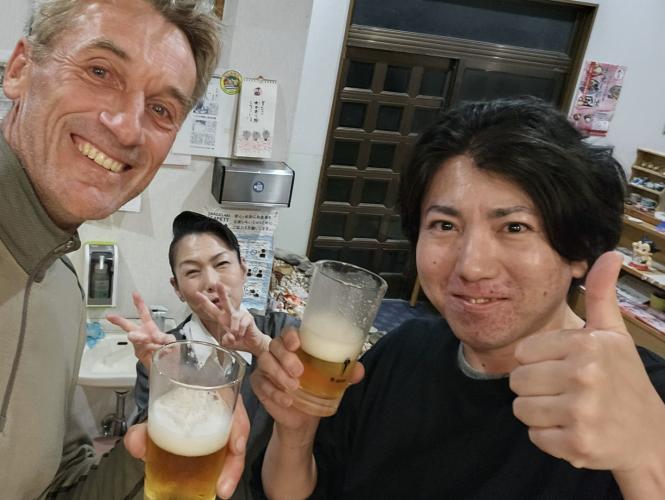Landmarks, Observations, Nagasaki
Japan Sea to East China Sea
It depends upon who you ask whether this boundary has been crossed. Most reference sources would say that the west facing coast of Kyushu is on the East China Sea, but the authority I usually go with (International Hydrographic Organisation, Limits 1953) puts the boundary meeting the coast at Noma Saki (32°35′ N), at the southern tip of the Nishisonogi Peninsula, a few miles south of Nagasaki.
Regardless, the sea since turning the NW corner of Kyushu has a very different feel. There are lots of islands, most of the time there are no waves, water and air getting much warmer, and there are real tides. By "real tides" I mean there is a current that switches direction, and there is rise and fall of at least a few metres. It has been a joy to sometimes be pulled along by that current.
Increasingly it feels more tropical. The vegetation is much less coniferous and far more jungly. In my last update, I forgot to mention that I saw a monkey!
A sign in a local conveniences also warned that the blue ringed octopus is being found locally, and to be careful of these as their bite delivers a highly venomous neurotoxin. So much to remember...
Japan's Westermost Mainland Point - Kōzakihana
I definitely passed this one. The caveat this time being that by mainland we mean the four "main" islands of Honshu, Hokkaido, Kyushu and Shikoku. The easternmost and northernmost points were in Hokkaido. To complete the set I need to go round the southernmost tip of Kyushu.
Nagasaki
The depth to my cultural education in Japan has rarely gone deeper than convenience stores and family restaurants, so I was keen to visit Nagasaki rather than simply sail past the city. Just in case it needs saying, in August of 1945, Nagasaki and Hiroshima had atomic bombs dropped on them which led to Japan's surrender and the end of World War II. Hiroshima received the first bomb, while Nagasaki received the second bomb three days later. Interestingly, the Nagasaki bomb was destined for Fukuoka, but that city was spared by bad weather and a faulty fuel pump in the auxiliary fuel tank of the plane that dropped the bomb. My mate Jimmy told me this, because his dad was a prisoner of war in Fukuoka, and - without those coincidences - he wouldn't be here.
With rain on the way, I looked for a nearby small port with a good bus connection, and took a half day, and went into the city. There is a nice park, full of hope for a more peaceful world. It is easy to be despondent about the state of the world and current conflicts, but the memorial was moving rather than gloomy. Japan and America are now friends and allies. Enemies must eventually become friends. It doesn't do to be dogmatic.
Random Acts of Kindness
At the bridge to Oshima Island, I made a stop I assumed would be uneventful. When I was inflating my mattress ready for sleeping, a family from a local venue tentatively introduced themselves and asked if I was OK. I was fine, I explained, but - yes - some water would be welcome. A litre of water came, and with it an offer to sleep inside. Do I like beer? Sukoshi - a little. I was ready to offer stories of my travels, but after the first kampei - cheers - found that I had been left alone with the view over the strait and the remainder of my glass.
In the morning, I found a plate of food for breakfast, and was then left "home alone" until ready to leave. Arigato gozaimasu Sumi-san and family.
The Sailing and Other Bits
Its been all upwind sailing lately with unremarkable but reliable progress. Conditions have been ideal for Raceboard: flat water, scenery to admire and where the occasional stop can be made. Idyllic. In some place the current has been strong, and there has been a lots of boat traffic, including a few sailing yachts.
I made a modification to my "bridge" system to keep the sail better seated when in paddle mode. My bivvy bag received an upgrade to keep the material off my face. I repaired my boots (big toe poked through), and sewed-up my frayed drysuit undergarments.
The seaweed collectors in this tidal area collect a seaweed similar to the Essex samphire (Salicornia europaea) that my grandmother used to pickle. The harvesting happens at low tide when the rocks are exposed.
Ospreys are very numerous. Rarely does a stack or navigational beacon not have an osprey nest atop it. Red Kites are common too. They will also take small fish, and sometimes rob food, or faux attack to provoke a fumble of an onigiri rice ball.
 Kampei! (Cheers!) Selfie with Sumi-san and his mother
Kampei! (Cheers!) Selfie with Sumi-san and his mother